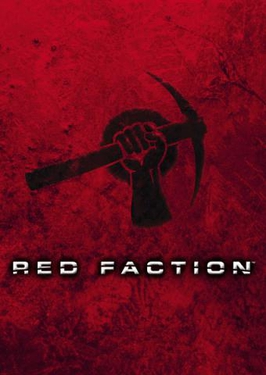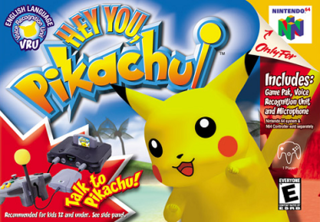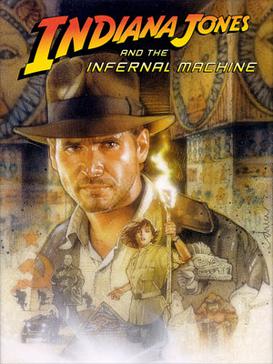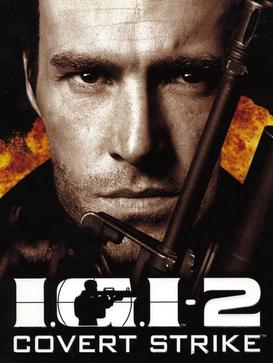
Red Faction is a first-person shooter video game developed by Volition and published by THQ for PlayStation 2 and Microsoft Windows in 2001, and Macintosh platforms in 2001 and 2002. A version for the N-Gage was developed by Monkeystone Games, and the mobile version was developed by Blue Beck. The game was inspired by several works of contemporary science fiction.

Microsoft Train Simulator is a 2001 train simulator game developed by UK-based Kuju Entertainment and published by Microsoft Games for Windows. It was released on June 18, 2001.

Hey You, Pikachu! is a virtual pet Pokémon spin-off video game for the Nintendo 64 developed by Ambrella and published by Nintendo. It was released in Japan on December 12, 1998, and in North America on November 6, 2000. The player is asked to help Professor Oak test the PokéHelper, a device that lets humans communicate with Pokémon. The game is set in the Kanto region between Pewter City and Viridian City, where the player is introduced to a wild Pikachu. The player is able to communicate with a 256-word database through the Voice Recognition Unit (VRU), a Nintendo 64 hardware accessory that, when paired with a microphone, can comprehend and analyze human speech. Along with speaking with Pikachu, the VRU allows the player to move around and gather items.

Half-Life: Blue Shift is an expansion pack for the first-person shooter video game Half-Life (1998). It was developed by Gearbox Software and published by Sierra On-Line. Blue Shift was the second expansion for Half-Life, originally intended as part of a Dreamcast port of Half-Life. Although the Dreamcast port was cancelled, the Windows version was released as a standalone product on June 12, 2001 for Windows. It was released on Steam on August 24, 2005.

Hitman: Codename 47 is a stealth video game developed by IO Interactive and published by Eidos Interactive for Microsoft Windows in November 2000. In the game, players control Agent 47, a genetically enhanced human clone who is rigorously trained in methods of murder. Upon escaping from his testing facility, 47 is hired by the International Contract Agency (ICA), a global contract killing organization. His missions take him to locations in Asia, Europe, and South America to assassinate wealthy and decadent criminals, who at first seem to share no connections with each other, but are soon revealed to have all played a role in a larger conspiracy. The gameplay revolves around finding ways to stealthily reach and eliminate each target; to this end, players can make use of various tools, including disguises and suppressed weaponry. However, some levels are more action-focused and do not feature stealth as a possibility, instead playing like a traditional third-person shooter.

Driver 2 is a 2000 action driving video game and the second installment of the Driver series. It was developed by Reflections Interactive and published by Infogrames for PlayStation. A port to the Game Boy Advance, titled Driver 2 Advance, was released in 2002, developed by Sennari Interactive and released under Infogrames' Atari range of products.

Worms World Party is a 2001 artillery turn-based tactics video game developed by Team17, and is the sequel to Worms Armageddon in the Worms series. As with the previous games in the series, players take turns controlling their teams and using available projectiles, firearms, explosives, and equipment to destroy all opposing teams and manoeuvre across a specified and highly destructible map.

Indiana Jones and the Infernal Machine is an action-adventure video game by LucasArts released in 1999. The first 3D installment in the series, its gameplay focuses on solving puzzles, fighting enemies, and completing various platforming sections. The story is set in 1947, after the events of Indiana Jones and the Iron Phoenix, and puts the eponymous protagonist, the adventurer Indiana Jones, against the Soviet Union. In a race for a mythological Babylonian power source, he joins forces with the Central Intelligence Agency and collects four pieces of the Infernal Machine, an ancient device that allegedly opens a portal to another dimension.

NBA Live 2001 is the 2001 installment of the NBA Live video games series. The cover features Kevin Garnett as a member of the Minnesota Timberwolves. The game was developed by EA Canada and published by Electronic Arts under the EA Sports Label. NBA Live 2001 is followed by NBA Live 2002. The PC version of the game for the second year included EA's "Face in the Game" feature that debuted in NBA Live 2000, allowing players to use custom facial photographs on created players.

The Simpsons Wrestling is a sports video game based on the animated television series The Simpsons for the PlayStation. Developed by Big Ape Productions and published by Fox Interactive through a co-publishing agreement with Electronic Arts in Europe and Activision in North America, the game was first released in Europe in March 2001, followed by North America a month later. It is the only Simpsons video game released for the PlayStation.

WWF SmackDown! 2: Know Your Role, known in Japan as Exciting Pro Wrestling 2, is a professional wrestling video game developed by Yuke's released in November 2000 on the PlayStation by THQ. It is the sequel to WWF SmackDown!, and the second game in the SmackDown series, itself based on the World Wrestling Federation professional wrestling promotion.

Delta Force 2 is a tactical first-person shooter video game developed by NovaLogic and released in 1999. It is the second game in the Delta Force series and was followed by Delta Force: Land Warrior one year later. The game was re-released in 2009 on Steam.

Theme Park Inc. is a construction and management simulation video game. It is the sequel to Theme Park World (1999). Theme Park Inc. was developed by Bullfrog Productions and published by Electronic Arts. It was the last game to bear the Bullfrog logo before the company's merger with EA UK in 2004.

Colin McRae Rally 2.0 is a racing video game developed and published by Codemasters for PlayStation, Microsoft Windows and Game Boy Advance.

I.G.I.-2: Covert Strike, known in the PAL region as Project I.G.I. 2, is a 2003 tactical shooter video game developed by Innerloop Studios and released by Codemasters. The game is a stealth-based first-person shooter. It is the sequel to Innerloop's Project I.G.I.. The original, published by Eidos Interactive, offered only single-player play, and no game saves. Covert Strike added multiplayer play and limited save game capability. Chris Ryan, a former Special Air Service operative best known for being the lone successful escapee of Bravo Two Zero, served as a consultant to the game.

The Mummy, known in Japan as Hamunaptra: Ushinawareta Sabaku no Miyako, is a single-player video game for Game Boy Color, PlayStation and Microsoft Windows, based on the 1999 movie of the same name. It was published by Konami.

Sega Extreme Sports is a sports game developed by Norwegian video game development company Innerloop Studios. It was released under a variety of names and published by many companies.

FIFA 2001 is a football simulation video game and the sequel to FIFA 2000. It was succeeded by FIFA Football 2002. It features Paul Scholes on the UK cover and Ben Olsen on the North American cover. The game's Spanish cover features Gaizka Mendieta on it. It was released on 31 October 2000 for Microsoft Windows and PlayStation, and on 24 November 2000 for PlayStation 2 as a launch title in Europe. The PlayStation 2 version was originally slated for release in the U.S. on 7 November, before it was delayed to 28 November. A Game Boy Color version was planned but cancelled.

MTV Sports: Skateboarding Featuring Andy Macdonald is a sports video game developed by Darkblack and published by THQ for Game Boy Color, Microsoft Windows, PlayStation and Dreamcast. It features skateboarder Andy Macdonald on the cover.

Enad Global 7 AB is a Swedish video game holding company based in Stockholm. It was founded as Toadman Interactive in 2013 by Robin Flodin and Rasmus Davidsson as a work-for-hire consultancy studio. The company began fully developing games in 2017 and became a public company later that year. Starting in 2018, Toadman Interactive acquired other video game companies, including the developer Antimatter Games, marketing agency Petrol Advertising, and publisher Sold Out. In January 2020, Toadman Interactive reformed as Enad Global 7, organising Petrol Advertising, Sold Out, and the renamed Toadman Studios as its direct subsidiaries. Since then, Enad Global 7 has acquired Big Blue Bubble, Piranha Games, Daybreak Game Company, and Innova. In August 2021, the management was replaced with Daybreak Game Company's Ji Ham as acting chief executive officer (CEO) and Fredrik Rüdén as deputy CEO and chief financial officer, with Floding leaving the company and selling all shareholdings by May 2022. Innova was sold off in September 2022 due to the 2022 Russian invasion of Ukraine.




















